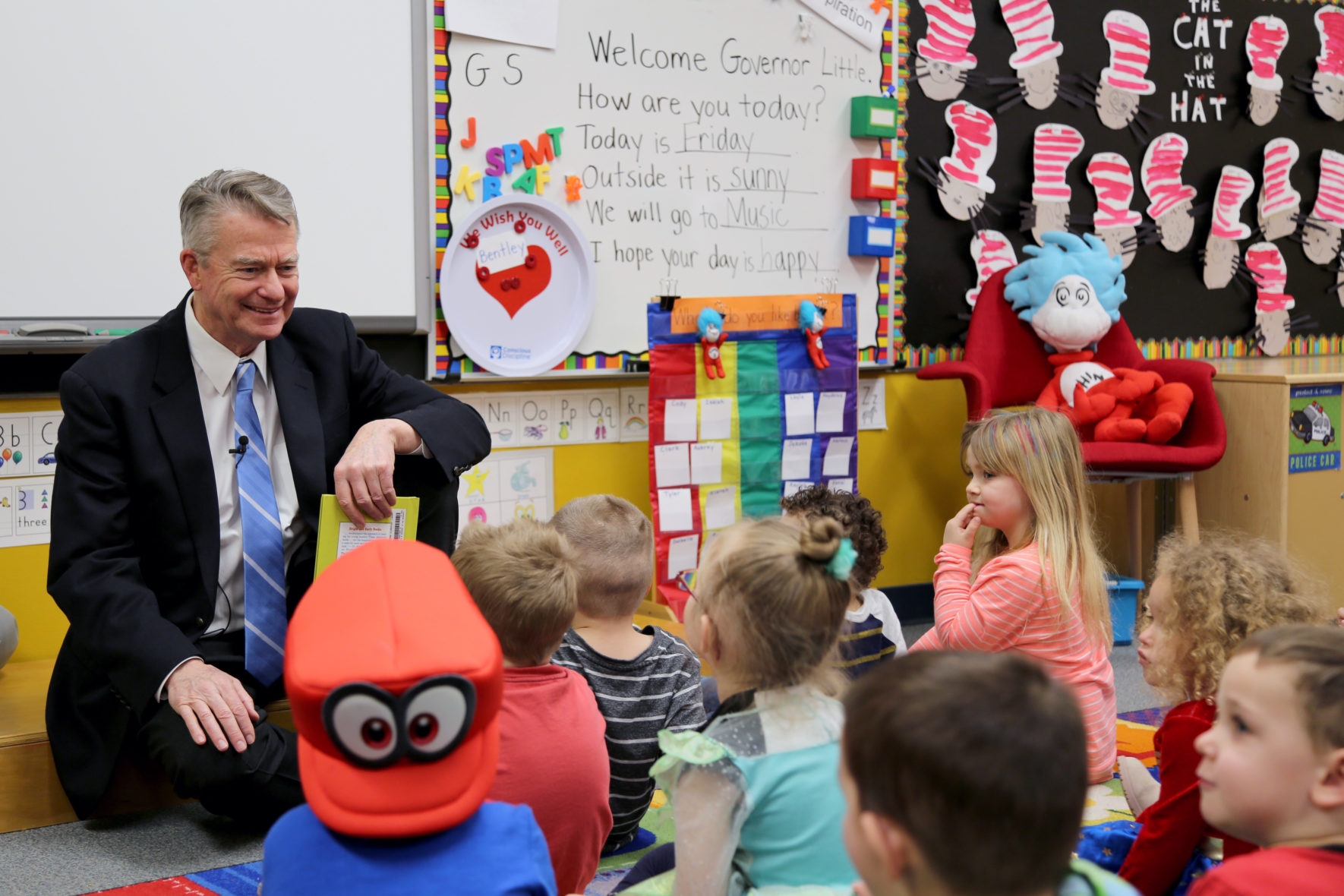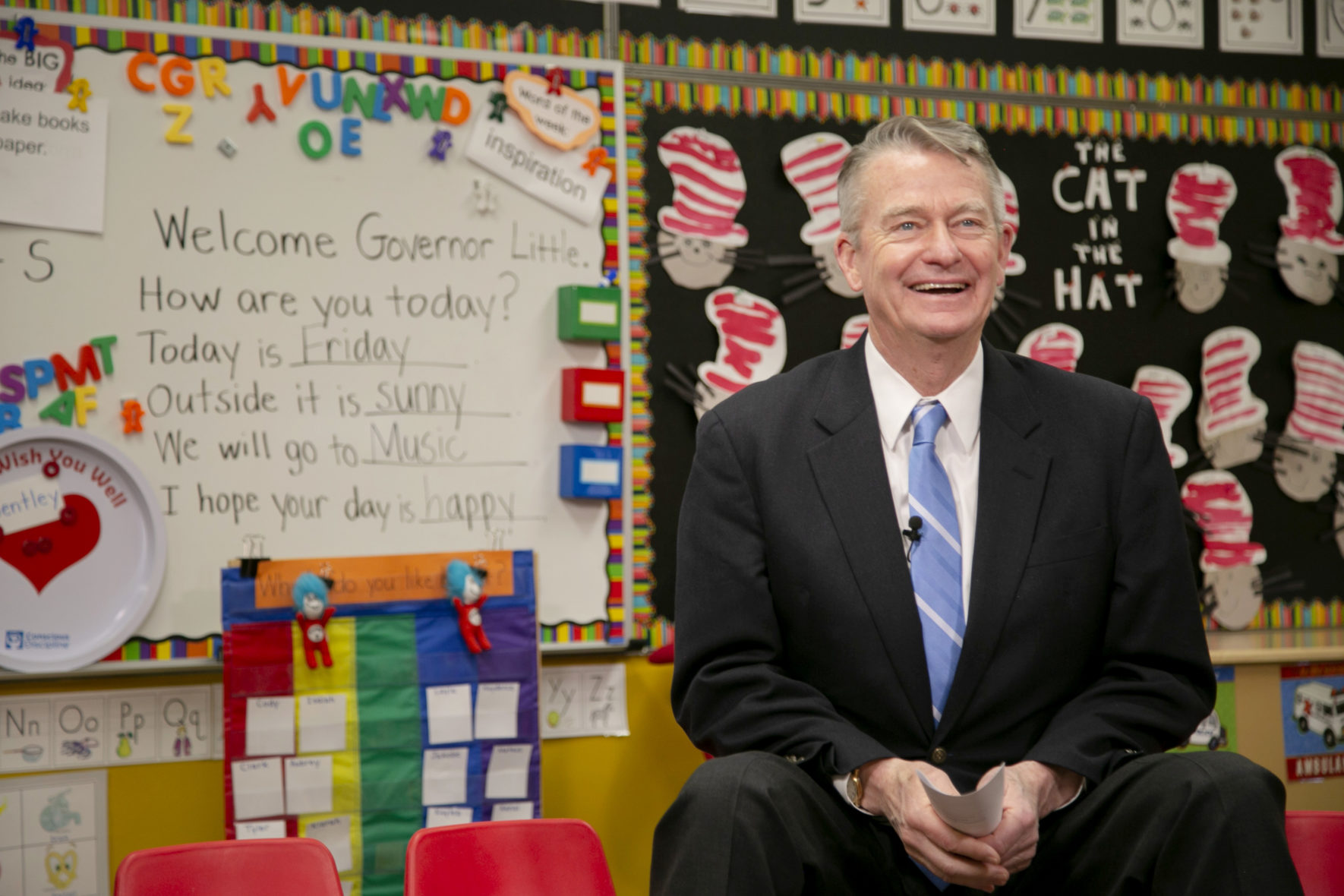First year Gov. Brad Little’s mouth flies open and his eyes light up as he cracks open a Dr. Seuss book.
Seated near his feet are 15 students in Grace Ruddy’s preschool class at Hawthorne Elementary.
One boy has blue hair. Another is dressed as Spiderman. A girl is decked out in a Wonder Woman costume. Another proudly wears a teal princess’ gown.

Ruddy and another teacher dress as a couple of Seuss characters — Thing 1 and Thing 2.
Little is dressed as a rancher who grew up to be a politician, wearing a dark jacket and blue tie as he sits cross-legged and begins to read.
Tomorrow, Little tells the children, is Dr. Seuss’ birthday.
“Did you ever have the feeling there is a WASKET in your BASKET? Or a NUREAU in your BUREAU?” Little reads.
Many of the 4-year-olds don’t have any idea what a bureau is, much less a nureau. But they pick up on the silliness and rhyming scheme embedded in “There’s a Wocket in My Pocket” and begin to squirm about on the carpet, cooing and giggling in delight as Idaho’s 33rd governor makes funny faces.
“’A WOZET in your CLOSET’ does that rhyme?” Little asks.
The children laugh again. Of course it rhymes.
Little laughs too, but he loses focus momentarily.
“Governor, can you hold it up and show them the pictures?” a teacher gently reminds him.
Little doesn’t heavily promote these school visits. But since he was sworn in Jan. 7, Little has snuck out of the Statehouse three times to visit schools. He says the visits help him stay focused on his top education priority — ensuring Idaho’s youngest students can read.
“The whole concept of getting these kids reading proficiently by the end of the third grade starts with this classroom that we just came out of,” Little said.

When prompted by Idaho Education News, Little reflects on his second grade teacher at Emmett’s Butte View Elementary. Something special happened that year. Little said his teacher helped him transform reading from a chore to a joy.
This year, Little is leading the charge to double the state’s investment in the K-3 literacy initiative, pushing for $13 million in new money.
He wants Idaho’s children to have the same breakthrough he did early in his elementary school career.
“If we’re going to spend half of the state budget on education, we darn sure better get them reading proficiently by the end of the third grade,” Little said.
After reading to Hawthorne students, Little sat down with Idaho EdNews for a 15-minute conversation about his education priorities and the 2019 Legislative session.
(Questions and responses have been lightly edited for clarity and space considerations).
Question: From an education perspective, how is the legislative session going?
Little: “Good. Our two top (priorities) — starting teacher pay and literacy — are both going forward and we are delighted about that. The funding for (a new task force called) Our Kids Idaho’s Future is embedded into the budget. Those are our three big ones. The Opportunity Scholarship (expansion) is in the higher ed budget so all of those things are all great.”
Q: Do you think the proposal to rewrite Idaho’s public school funding formula will pass this year?
Little: “I don’t know, I hope so. We know that we’ve got some incentives in the current school funding formula that don’t align with what most people agree we ought to do in education but the problem is, for the most part, it’s a zero-sum game if you put more money into it. A school district that started a program predicated on the current funding formula, we don’t want to overpenalize them for trying to do good things for their districts and their kids. But on the other hand, if we’ve got incentives that don’t align with our overall goal for education we want to move towards a common denominator. How do we address small districts? How do we address English language learners? How do we address children at risk? And that’s what the Legislature is grappling with.”
Q: Should legislators extend the session to make sure they get the funding formula done?
Little: “I don’t think the funding formula is an issue… that it’s good for the Legislature for me to demand action on it. It needs to be thoughtful. It needs to be inclusive. I’d prefer that it not be an end of session (decision where legislators are) maybe making some compromises… it’s tough. The interim committee has been working on it, they’ve had an incredible consultant in. You know it may take a little longer. I’d love to see it done this year, but the most important thing is that we do it right.”
Q: We just left a pre-K classroom. Your education priorities for this year are already on the table. But is state pre-K something that’s on your radar for future years in your administration?
Little: “We are not doing enough at K-3 and that is where I am emphasizing. Here in the Treasure Valley we’ve got… I know of four or five (pre-K programs) and I’m not counting Boise. I’m talking about Caldwell and Basin School District and there is a lot of pre-K that exists in the public school system in the Boise valley and that is great…
“We have an obligation and it’s in code in K-3. But pre-K is definitely something most parents, a lot of parents I know, are fortunate enough to have resources to send their kids to pre-K and a lot of communities are electing to help those parents who don’t have those resources to make pre-K classes available.”
Q: You’ve called for a new task force to on education issues. How will that be created, who would you like to serve on the task force and when will it get to work?
(Editor’s Note: The House killed the State Board budget Thursday, several days after Little answered this question. That budget will be rewritten).
Little: “The appropriation’s in the State Board budget. In my discussions with leadership, my discussions with leaders of the germane committees, everybody concurs that now that we are winding up the last task force we need to do the next one. And we need to look back at what we’ve done. We’ve got quite a few elements of education funding that’s, for lack of a better word, on autopilot. Obviously, enrollment is, obviously, we always adjust for enrollment but advanced opportunities, bond levy equalization, those programs that basically are determined by who shows up and applies for the money. As we go forward and want to continue to invest in our educators, whether they’re starting teachers or the most senior (teachers), we need to know what kind of financial obligations we have on the budget so we can address… that element.
“We want to have all the stakeholders (on the new task force). Here’s what I’m, not wrestling with, but, I want this committee to work, so I don’t want it to be too big. But I want it to be inclusive of obviously the State Board, the trustees, the superintendents, the teachers. But I don’t want it to be too big. I want it to get things done, and that’s what we’re wrestling with right now. (After) we get through with the Legislature we’ll start putting meat on the bones.
“The other thing we are working on is my children’s task force…. There we’re talking about, you know, everything — foster children, everything we’re doing in child nutrition and also education will be a part of it. I want that group to give me advice in the summer and the fall as we put our budget together so that we’ve got a cohesive plan on all the different programs, to do the best possible job at taking care of our kids.”
